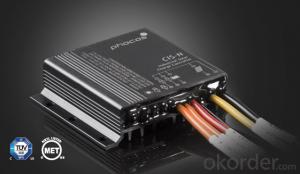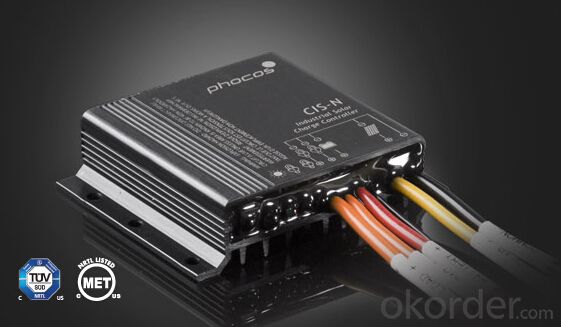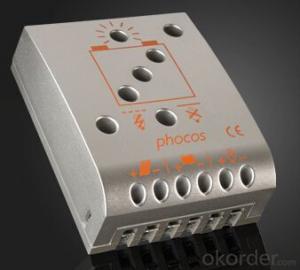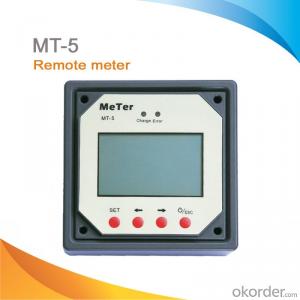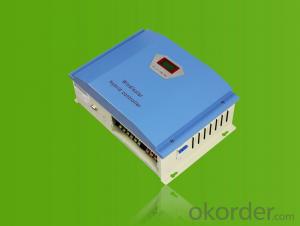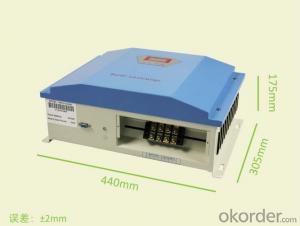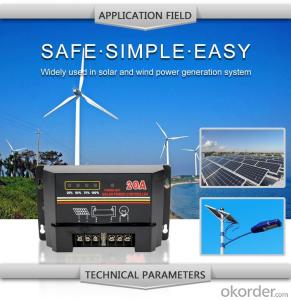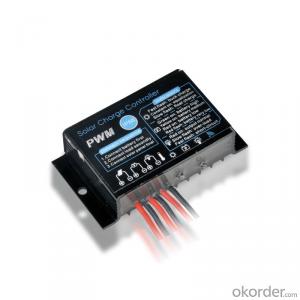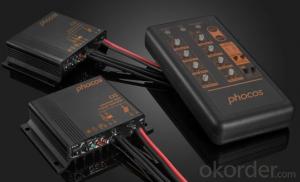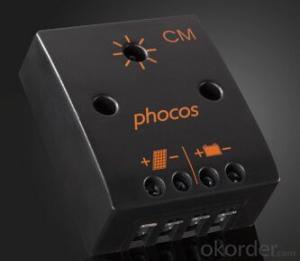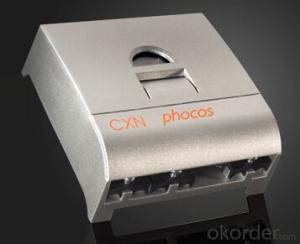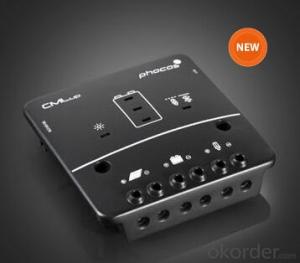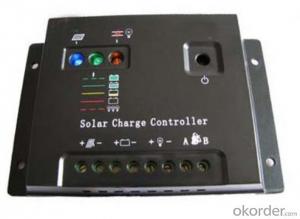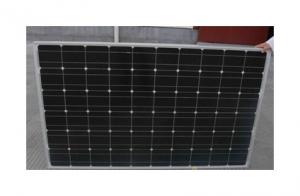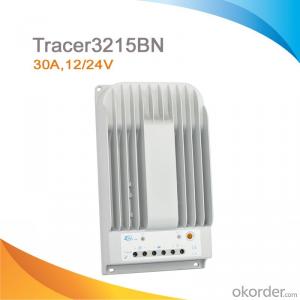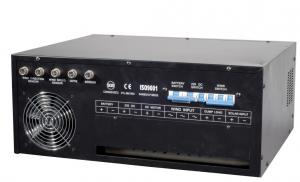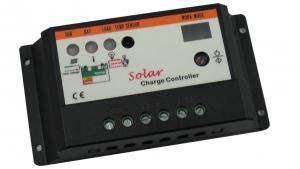Solar Charging Controllers - CIS-N Series (5 – 20 A) Solar Charge Controller
- Loading Port:
- China Main Port
- Payment Terms:
- TT OR LC
- Min Order Qty:
- -
- Supply Capability:
- 10000 unit/month
OKorder Service Pledge
OKorder Financial Service
You Might Also Like
· For applications in demanding and harsh environments (e.g. oil and gas industry)
· Negative grounding
· Robust aluminum housing
· Epoxy encapsulated PCB to prevent corrosion (IP68)
· Infrared remote control programming accessory (CIS-CU)
· Timer functions
· Wide range of programmable functions
· External temperature sensor (optional)
· 4-stage battery charging (main, float, boost, equalization)
· Dual load or dimmable load output
· Automatic system voltage recognition (12/24 V)
· Compact size
The Phocos CIS-N Charge Controller is one of the latest members of the successful Phocos family of fully encapsulated, high-performance CIS charge controllers providing optimum performance. Thanks to its high protection class (IP68), the CIS-N is ideal for applications in demanding environments such as the gas and oil industry (e.g. remote monitoring, weather stations, valves controlling, SCADA, and many more). It is also perfect for any solar outdoor applications which are exposed to harsh weather conditions. CIS-N was specially developed as a charge controller for applications requiring negative grounding, and features the identical properties as the popular positive-grounded CIS.
· It is available in two versions: A single load version with dimming output and a dual load version with two load outputs for independent control of two loads.
· The timer and other useful functions are completely programmable via the CIS-CU remote control unit. The small size of the devices offers extra flexibility, fitting easily into almost every application.
- Q: What are the advantages of using a solar controller in a solar power system?
- The advantages of using a solar controller in a solar power system are numerous. Firstly, it helps regulate the charging process of the battery, ensuring optimal charging and preventing overcharging or deep discharging. This extends the lifespan of the battery and improves its overall performance. Additionally, a solar controller provides protection to the solar panels by preventing reverse current flow during nighttime or low light conditions. This safeguards the panels from potential damage and maximizes their efficiency. Moreover, a solar controller typically features built-in temperature compensation, which adjusts the charging voltage according to the temperature. This compensates for fluctuations in temperature and ensures consistent and efficient charging of the battery. Furthermore, many modern solar controllers come with advanced features such as LED displays, programmable settings, and data logging capabilities. These features enable users to monitor and optimize the performance of their solar power system, making it more user-friendly and efficient. Overall, using a solar controller in a solar power system offers advantages such as battery protection, increased efficiency, temperature compensation, and enhanced system monitoring capabilities.
- Q: Can a solar controller be used with PWM (Pulse Width Modulation) technology?
- Yes, a solar controller can be used with PWM (Pulse Width Modulation) technology. PWM technology is commonly used in solar charge controllers to regulate the charging and discharging of batteries in solar power systems. The controller uses PWM signals to efficiently control the flow of energy from the solar panels to the batteries, ensuring optimal charging and prolonging the lifespan of the batteries.
- Q: What are the different charging modes supported by a solar controller?
- The different charging modes supported by a solar controller typically include bulk charge, absorption charge, float charge, and equalization charge.
- Q: How does a solar controller handle the protection against voltage fluctuations?
- A solar controller handles protection against voltage fluctuations by constantly monitoring the voltage output from the solar panels. It regulates the charging process by adjusting the charging current and voltage to prevent overcharging or undercharging of the batteries. This ensures that the batteries are charged optimally and protected from any potential damage caused by voltage fluctuations.
- Q: What is the purpose of the low voltage disconnect feature on a solar controller?
- The purpose of the low voltage disconnect feature on a solar controller is to protect the batteries from over-discharge. When a battery is discharged below a certain voltage level, it can cause irreversible damage and significantly reduce its lifespan. The low voltage disconnect feature monitors the battery voltage and disconnects the load, such as appliances or devices, from the battery when the voltage drops below a predetermined threshold. This helps to prevent the battery from being drained too much and ensures that it retains enough charge for proper functioning and longevity. By disconnecting the load, the low voltage disconnect feature helps to safeguard the battery and optimize its performance in a solar power system.
- Q: How do you protect a solar controller from dust and debris?
- One way to protect a solar controller from dust and debris is by installing it inside an enclosure or a sealed box. This will prevent any particles from entering and potentially damaging the controller. Additionally, regular cleaning and maintenance of the surrounding area can help minimize the accumulation of dust and debris.
- Q: Can a solar controller handle power fluctuations from the battery bank?
- Yes, a solar controller is designed to handle power fluctuations from the battery bank. It regulates and stabilizes the flow of power between the solar panels and the batteries, ensuring that the battery bank receives a consistent and appropriate level of charge. This helps to protect the batteries from overcharging or undercharging, and ensures efficient utilization of the solar energy.
- Q: What is the maximum battery voltage for a solar controller?
- The maximum battery voltage for a solar controller typically depends on the specific model and manufacturer. However, most solar controllers are designed to work with battery systems that have a maximum voltage of 12 volts, 24 volts, or 48 volts. It is important to consult the specifications and guidelines provided by the manufacturer to ensure compatibility and avoid any damage to the controller or battery system.
- Q: How does a solar controller handle voltage spikes from the solar panels?
- Solar controllers are designed to regulate and control the flow of electricity from solar panels, either to charge batteries or power electrical devices. To handle voltage spikes from the solar panels, the controllers have built-in protection mechanisms. One of the key features of a solar controller is its Maximum Power Point Tracking (MPPT) system. This system constantly monitors and adjusts the voltage and current from the solar panels to ensure maximum power output. By continuously tracking the optimal operating point of the solar panels, the MPPT system helps prevent voltage spikes and reduces the likelihood of voltage fluctuations. Additionally, solar controllers have overvoltage protection mechanisms. These mechanisms are designed to detect and limit any voltage spikes that may occur. When a voltage spike is detected, the controller automatically activates its protective measures to prevent damage to batteries or connected devices. This can involve diverting excess voltage to a dump load or temporarily disconnecting the solar panels from the charging system until the voltage returns to safe levels. In some advanced solar controllers, surge protection devices or transient voltage suppressors may also be incorporated. These components are specifically designed to absorb and dissipate excess electrical energy caused by voltage spikes. By diverting the extra energy away from the system, these devices help protect the controller, batteries, and other connected components from potential damage. Overall, solar controllers are equipped with various protective mechanisms to handle voltage spikes from solar panels. These mechanisms work together to regulate voltage, track the maximum power point, and safeguard the system from sudden voltage surges. This ensures the smooth and efficient operation of the solar power system while protecting its components from potential harm.
- Q: How do you prevent short-circuiting of solar panels with a solar controller?
- A solar controller helps prevent short-circuiting of solar panels by regulating the flow of electricity from the panels to the battery or load. It uses various protective mechanisms like overcurrent protection and overvoltage protection to ensure that the electrical output from the panels remains within safe limits. Additionally, many solar controllers also provide temperature compensation to prevent overheating and potential short-circuits.
Send your message to us
Solar Charging Controllers - CIS-N Series (5 – 20 A) Solar Charge Controller
- Loading Port:
- China Main Port
- Payment Terms:
- TT OR LC
- Min Order Qty:
- -
- Supply Capability:
- 10000 unit/month
OKorder Service Pledge
OKorder Financial Service
Similar products
Hot products
Hot Searches
Related keywords
